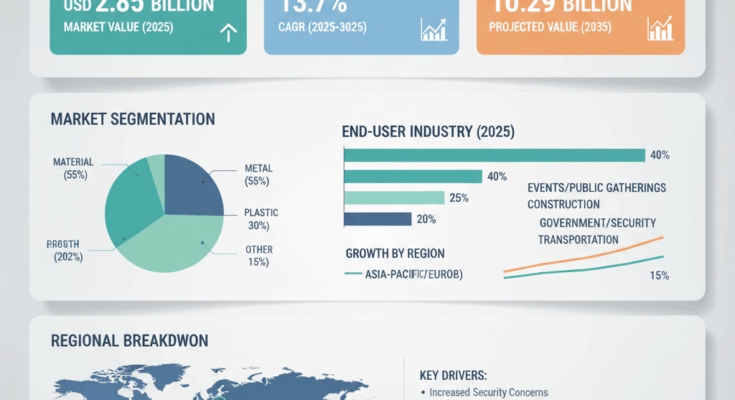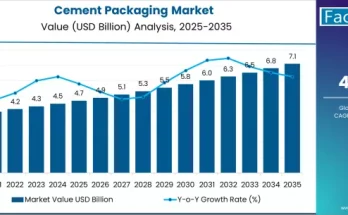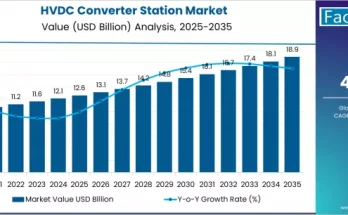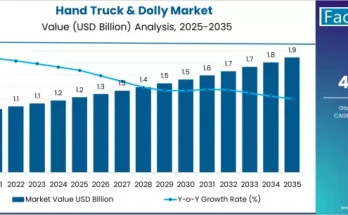The global crowd control barrier market is a dynamic and fast-growing industry driven by rising public safety investments, expanding event infrastructure, and smart city initiatives. The market is valued at USD 2.85 billion in 2025 and is projected to surge at a CAGR of 13.7%, reaching USD 10.29 billion by 2035.
In the following sections, we explore market segmentation—by type, material, function, usage, ownership, application, and region—alongside recent developments, key players, and competitive trends that define the sector.
Market Segmentation & Growth Drivers
By Type
Among the various types, fence barriers dominate due to their durability and suitability for high-traffic outdoor environments such as parades, demonstrations, stadiums, and public gatherings. Other types, including post & rope, post & chain, belt barriers, and modular fence systems, are preferred for controlled indoor crowd management applications.
By Material
Steel barriers are the most widely adopted globally due to their robustness and compliance with safety regulations, making them ideal for large public venues and permanent installations. Aluminum, plastic, and hybrid materials are also gaining popularity, particularly for indoor or temporary setups where portability and ease of handling are important.
By Function
Crowd control barriers can be expandable or non-expandable. Non-expandable barriers are used in semi-permanent or fixed installations, such as airports, sports venues, and government facilities. Expandable or collapsible barriers, on the other hand, are increasingly popular for events that require quick assembly, flexible placement, and easy storage.
By Usage
The outdoor segment leads the market, driven by public infrastructure projects, city events, and large gatherings. Indoor usage—such as in malls, hospitals, and exhibition centers—is also expanding as organizations prioritize efficient crowd flow and safety within enclosed spaces.
By Ownership
Traditionally, private ownership has been the dominant model, as organizers and facility managers prefer owning their equipment for frequent use. However, the rental and lease model is rapidly growing, especially in developed regions, as it offers flexibility, cost efficiency, and scalability for short-term or seasonal requirements.
By Application
Applications of crowd control barriers span public places, commercial spaces, and other specialized uses. Public places—including airports, railway stations, and government facilities—account for the largest share due to heightened security and safety mandates. Commercial spaces like shopping malls, event venues, and sports arenas are also strong contributors to market demand.
By Region
Regionally, the market is segmented into North America, Latin America, Europe, East Asia, South Asia & Oceania, and the Middle East & Africa.
- North America continues to lead in terms of technological adoption and large-scale event infrastructure.
- Europe follows closely, supported by urban safety regulations and sustainable construction initiatives.
- East Asia, especially China, is witnessing the fastest growth due to urbanization, public infrastructure expansion, and international event hosting.
- South Asia, Oceania, and the Middle East are also emerging markets with significant investments in smart cities and public safety measures.
Recent Developments & Competitive Landscape
Recent Developments
The market is evolving with a strong emphasis on innovation and sustainability. Recent trends include:
- Smart and modular designs that enhance flexibility, allowing for easy installation and transportation.
- Integration of IoT, RFID, and sensors to enable real-time monitoring of crowd density and barrier usage.
- Eco-friendly production practices using recycled or recyclable materials to meet sustainability goals.
- Growth in the rental model, enabling event organizers to manage costs efficiently.
- Introduction of AI-enabled barriers for better security analytics and automated crowd management.
These developments reflect the industry’s shift toward intelligent, environmentally responsible, and adaptable solutions.
Key Players & Competitive Analysis
The market is moderately consolidated, with several global leaders and numerous regional players contributing to its competitive dynamics.
- JAKOB Group (Switzerland) focuses on modular, AI-driven systems and has expanded its presence through partnerships and large-scale installations in public infrastructure projects.
- A-SAFE (UK) is a pioneer in polymer-based safety barriers, emphasizing recyclable and smart-enabled designs.
- Delta Scientific (USA) specializes in retractable and hydraulic barriers, primarily for defense and airport applications.
- HERAS (Netherlands) offers modular fencing systems and has secured contracts in major sports and renewable energy facilities.
- Mojo Barriers BV (Netherlands) provides event-focused solutions with integrated NFC and access control systems.
- Frontier Pitts / ATG Access (UK) combines crowd and traffic management through hybrid bollard and perimeter security systems.
Additionally, regional firms such as Tamis Corporation, Viking Fence, PRO-TEK Temporary Fencing, ZND UK Ltd, Seton, US Netting Inc., and Ideal Shield compete on innovation, price, and service flexibility.
Competition increasingly revolves around product innovation, smart integration, sustainability, and rental service networks. Companies that adopt adaptive business models and advanced manufacturing processes are gaining a strategic advantage.



